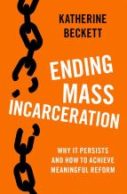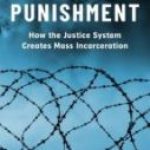Ending Mass Incarceration: Why it Persists and How to Achieve Meaningful Reform
 Author: Katherine Beckett
Author: Katherine Beckett
Publisher: Oxford University Press, 2022. 272 pages.
Reviewer: Gregory Brazeal | Winter 2025
In her 1997 book Making Crime Pay, the sociologist Katherine Beckett sounded an early alarm about the rise of incarceration rates in the United States. Long before “mass incarceration” became a household term, Beckett presciently warned that “a dramatic expansion of the criminal justice system” had resulted in the United States having the highest incarceration rate in the industrialized world, with minorities, and especially Blacks, being “especially affected” (3).
A quarter century later, concern about the United States’ reliance on carceral solutions to social problems has gone mainstream. But Beckett continues to sound the alarm. In her latest book, Ending Mass Incarceration: Why it Persists and How to Achieve Meaningful Reform (2022), she makes clear that recent efforts at criminal justice reform have largely failed to reverse what the criminologist Franklin Zimring has referred to as “the insidious momentum of American mass incarceration.”
In fact, despite its title, Ending Mass Incarceration is not a comprehensive guidebook to ending mass incarceration. It could just as accurately have been called How Not to End Mass Incarceration. The book is as much a critique of the inadequacies of recent criminal justice reforms as it is a roadmap toward reducing incarceration rates.
The first part of the book, “Understanding the Persistence of Mass Incarceration,” presents Beckett’s critique. On the one hand, Beckett shows that recent reform efforts have not been entirely rhetorical. She presents the results of a fifty-state analysis of new sentencing laws enacted between 2007, the peak year of the American incarceration rate, and 2016. The study reveals that “decarcerative reforms intended to reduce prison sentences and time served outnumbered incarcerative measures intended to do the opposite by a substantial margin.” Moreover, “this pattern was fairly consistent across the fifty states” (32).
On the other hand, Beckett’s legislative analysis also provides support for the political scientist Marie Gottschalk’s concern that reform efforts thus far have focused on the “nons”: “nonserious, nonviolent, and nonsexual crimes” (12). As Gottschalk feared, Beckett finds that “a clear majority of the decarcerative reforms were limited to nonviolent offenses; very few states adopted measures intended to reduce sentences or prison stays for people convicted of violent or other serious crimes” (33). To the contrary, Beckett’s analysis of news stories shows that “reform advocates quoted in the news often work hard to reassure public audiences that the reforms for which they advocated would not benefit people who are undeserving, particularly those convicted of violent crimes” (35).
Given that the majority of the people incarcerated in state prisons were convicted of a violent crime, it should not be surprising if decarceral reforms limited to the “nons” have left incarceration rates at levels that are exceptionally high not only by international standards but by the standards of recent American history. Beckett finds, in fact, that when American incarceration is measured not relative to population size but relative to crime rates, mass incarceration did not “peak” in 2007 at all. It is true that per capita incarceration fell 15 percent between 2007 and 2018. But serious crime—as measured by “the eight Part I ‘index’ crimes that are most likely to trigger a prison sentence”—fell even more. As a result, America’s “penal intensity,” that is, the number of incarcerated people relative to the number of reported felonies, continued to rise over the same period (10-11).
The limited reach of recent criminal justice reforms becomes even clearer when Beckett turns to a comparative analysis of rural, suburban, and urban criminal justice outcomes. Just as much of the public in the 1990s was unaware of the extraordinary rise in American incarceration rates, much of the public today may be unaware that residents of rural and suburban counties are more likely to be admitted to prison than residents of urban counties. As Beckett demonstrates through an analysis of National Corrections Reporting Program data from the years 2011 to 2013, “prison admission rates are highest in rural counties, despite the fact that those counties have far lower crime rates than large urban counties.” In addition, “the heightened propensity to imprison in suburban and rural counties exists for all kinds of cases,” not only drug cases as some have suspected. Beckett reasonably concludes that “the criminal justice reform movement has not reached a receptive audience outside of large urban areas” (52). Given the outsized political power of less densely populated areas in American democracy, as well as the exceptionally decentralized and politicized nature of American criminal justice, reforms that lack support outside of large cities seem unlikely to bring about transformative decarceration on a national scale.1
Part I concludes with a critique of the limitations of recent drug policy reforms. On the one hand, Beckett’s analysis of “state-level drug-sentencing statutes adopted between 2010 and 2016” confirms that “[m]any states have decreased criminal penalties for drug possession” (75), in addition to some states legalizing marijuana for recreational use. Perhaps in part as a result of reforms, “[t]he total number of people in state or federal prison as a result of a drug conviction fell by 32.3 percent from 2007 to 2017” (72). On the other hand, this only represents a return to “the very high enforcement level of the late 1990s” from “the super-high level of the mid-2000s” (72). Moreover, only “a very small share (3.5 percent) of the state prison population” consists of people imprisoned for drug possession, and state-level reforms have not prevented rural and suburban prosecutors and judges from “throw[ing] the book at people arrested on drug charges if they are so inclined” (73-74). In addition, “the majority of new laws affecting penalties for drug distribution actually enhanced rather than reduced sentences” (75).
In sum, Part I of Ending Mass Incarceration suggests that despite the growing visibility of critiques of mass incarceration in the 2010s, and the passage of some state-level reforms, the “tough-on-crime era” continued. In fact, the United States as a whole, led by areas outside of large cities, grew more punitive in its use of incarceration during these years.
Part II of Ending Mass Incarceration turns toward Beckett’s proposals for reform. As Beckett makes clear in her introduction, she does not aim to offer a comprehensive roadmap toward decarceration. She intends to “focus on solutions that are receiving comparatively little attention,” and even more specifically, on “solutions that have the potential to significantly reduce both the scope of punishment as well as the underlying problems—such as untreated addiction and interpersonal violence, which are in turn rooted in poverty and inequality—that also cause suffering” (14-15). The introduction notes in passing that in the short term, a list of “straightforward things we can and should do . . . to reduce incarceration” might include “ending cash bail, sending far fewer people to jail and prison, and confining people for shorter amounts of time when we do” (16). But such straightforward steps are not the primary focus of the book. Instead, she draws attention to three reforms that she suggests deserve greater attention.
First, Beckett argues “for comprehensive sentencing reform that creates a twenty-year maximum sentence as well as postconviction review processes that enable prisoners who have served many years behind bars to show they are safe to release” (94). In the course of her argument for sentencing reform, Beckett defends the conclusion, against a widely discussed recent criticism, “that the amount of time prisoners spend behind bars has been increasing” (95). Specifically, Beckett summarizes a variety of sources finding that time served for specific crimes or offense types increased between the 1980s and the 2000s, including, for example, Bruce Western’s conclusion that time served for violent offenses increased by 61 percent between 1980 and 2010.
Second, Beckett argues for the expanded use of restorative justice as an alternative to conventional, incarceration-focused criminal justice practices, especially in cases involving adults and violence that are often excluded from existing restorative justice programs. Drawing on works including Danielle Sered’s Until We Reckon, Beckett suggests that restorative justice can be especially promising as a decarceral reform “when paired with diversion, focusing on situations involving comparatively serious harm, and addressing the trauma and deprivation that people who cause harm have also experienced” (144).
Third, Beckett argues for responding to “the problem of unmanaged addiction and unregulated drug markets” with harm reduction strategies rather than the use of the criminal legal system. Although she argues that “[u]ltimately, legalization and regulation of drug markets is needed,” she recognizes that such legislation is unlikely “in the near or medium term” (173). In the meantime, Beckett suggests that there are better alternatives to “drug courts and other forms of court-based diversion and supervision” that are often promoted by contemporary reformers (173).
As an illustration of a harm reduction approach that does not involve the threat of punishment for noncompliance, Beckett describes the development of the “LEAD” (formerly Law Enforcement Assisted Diversion, now Let Everyone Advance with Dignity) program in Seattle. In the original version of LEAD, police officers who had probable cause to arrest someone for certain low-level charges could offer to bring the person to a LEAD case manager instead of arresting them and booking them into jail. If the person accepted, the case manager would work closely with the participant to develop a plan based on the participant’s needs and priorities, and would then intensively support the participant in achieving those goals, such as obtaining housing, social services, or employment. The program created an alternative to cycling in and out of jail on minor offenses related to addiction or extreme poverty. Based on its results in Seattle, LEAD “is now in place or in development in roughly one hundred jurisdictions around the country” (153).
Beyond the value of Beckett’s quantitative analyses and reform proposals, and her interventions in various scholarly debates, a final aspect of Ending Mass Incarceration deserves recognition. Throughout the book, Beckett emphasizes the political importance of popular assumptions about crime, blame, and punishment, and the way those assumptions are shaped by widely circulating narrative templates about the causes of crime. She returns repeatedly to the work of the social psychologist Craig Haney, who has observed that a “‘master crime narrative’ that emphasizes the centrality of the (evil) individual continues to serve as the bedrock of American jurisprudence” (36). In Haney’s words, “‘[i]f violent crime is the product of monstrous offenders, then our only responsibility is to find and eliminate them. On the other hand, social histories—because they connect individual violent behavior to the violence of social conditions—implicate us all in the crime problem’” (27).2 In an attempt to counter what she calls the “myth of monstronsity,” Beckett offers brief accounts of the life stories of five incarcerated people she met through working and teaching at the Washington State Reformatory (118-32). If a neoprogressive turn away from punitiveness in criminal justice and other public policies one day becomes politically feasible, the kinds of narratives that Beckett shares may play a role in facilitating the new policies’ arrival.
References:
- I expand on these points in a work-in-progress, “Rural Mass Incarceration and the Politics of Punitiveness.”
- I drew in part on the work of Philip Zimbardo, Haney’s collaborator in the Stanford Prison Experiment, to offer a similar argument in Gregory Brazeal, “Justice Theater in the Criminal Law Curriculum,” Cardozo Law Review, 45: 1723, 1766-82 (2024).
Gregory Brazeal is an Associate Professor at the University of South Dakota Law School, a former public defender in Seattle, and the author of The Hero and the Victim: Narratives of Criminality in Iraq War Fiction.


